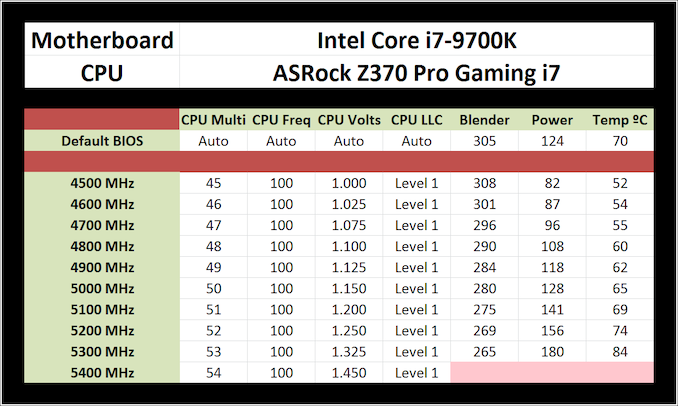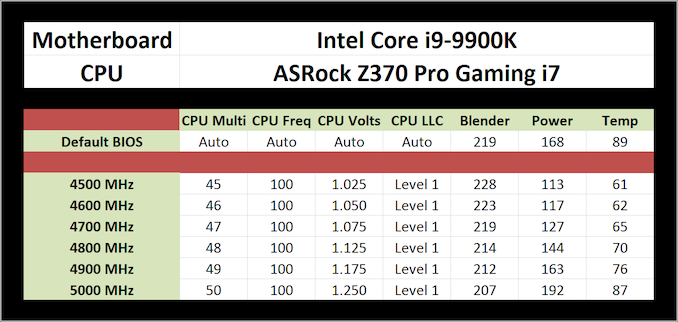The Intel 9th Gen Review: Core i9-9900K, Core i7-9700K and Core i5-9600K Tested
by Ian Cutress on October 19, 2018 9:00 AM EST- Posted in
- CPUs
- Intel
- Coffee Lake
- 14++
- Core 9th Gen
- Core-S
- i9-9900K
- i7-9700K
- i5-9600K
Overclocking
With the upgraded thermal interface between the processor and the heatspreader, from paste to solder, Intel is leaning on the fact that these overclockable processors should be more overclockable than previous generations. We’ve only had time to test the Core i9-9900K and i7-9700K on this, so we took them for a spin.
Our overclocking methodology is simple. We set the Load Line Calibration to static (or level 1 for this ASRock Z370 motherboard), set the frequency to 4.5 GHz, the voltage to 1.000 volts, and run our tests. If successfully stable, we record the power and performance, and then increase the CPU multiplier. If the system fails, we increase the voltage by +0.025 volts. The overclocking ends when the temperatures get too high (85C+).
For our new test suite comes new overclocking features. As mentioned in the previous page, our software loading for power measurement is POV-Ray, which can thrash a processor quite harshly. POV-Ray also does a good job on stability, but is not a substantial enough test – for that we use our Blender workload, which pushes the cores and the memory, and lasts about 5 minutes on an 8 core processor.
Results as follows:
For the Core i7-9700K, we hit 5.3 GHz very easily, for a small bump in power and temperature. For 5.4 GHz, we could boot into the operating system but it was in no way stable – we were ultimately voltage/temperature limited at this case. But an eight core, eight thread 5.3 GHz CPU at 180W for $374? Almost unimaginable a year ago.
Overclocking the Core i9-9900K was not as fruitful. The best bit about this overclock is the 4.7 GHz value: by using our own voltage settings, we reduced power consumption by 41W, almost 25% of the total power, and also reduced temperatures by 24ºC. That's a safe idea. Even 4.8 GHz and 4.9 GHz was reasonable, but the temperatures at 5.0 GHz might not be for everyone. When all cores and threads are loaded, this is one warm chip.












274 Comments
View All Comments
muziqaz - Monday, October 22, 2018 - link
I love the price of $488 stamped all over each of the test results, while over here in UK I see price of £599 and newegg quotes $580. Even your linked amazon has it at $580. And conclusion is awesome with: "At $488 SEP, plus a bit more for 'on-shelf price'..." Since when is extra 100 bucks a bit more? :Dcompudaze - Monday, October 22, 2018 - link
What was the actual vcore for your overclocks?HardwareDufus - Monday, October 22, 2018 - link
I7-9700k.... an I7 that isn't hyperthreaded.... let's totally muddy the waters now Intel.... Guess they had to save some feature for the I9's $100+ surcharge...… Good grief.bogda - Tuesday, October 23, 2018 - link
How pointless is reviewers comment: "... World of Tanks gives the 9900K some room to stretch its legs..."?Difference between two chips in discussion is between 712fps and 681fps! Not even Neo from Matrix could note the difference.
How pointless is discussing top of the line CPU gaming performance in 720p in any game??
How pointless is marketing 8C/16T CPU for gamers???
sseyler - Tuesday, October 23, 2018 - link
Not sure whether this has been pointed out yet, but the Threadripper prices need to be updated. For example, the 1920X is now well under $500 as advertised even on AMD's website and the 1900X goes for $350 on Newegg.dlum - Tuesday, October 23, 2018 - link
For me, listing the long-obsolete prices for AMD processors (still initial, long-outdated MSRP for 1920x $799 - whereas a simple amazon search confirms it's now for just over half of that ($431)) is clearly disrespectful and shamefull practice for a reviewer.It's very sad such dishonest practices found their way to Anandtech and they are so prominent here.
Probably that's also why no one answers nor fixes those clearly misleading figures.
(Maybe that's the cost of being able to read such anyway valuable reviews for free :)
sseyler - Thursday, October 25, 2018 - link
Well, to be fair, I'm sure the editors didn't dig this deeply through the comments. They're busy people.Also, I think I heard something mentioned before about their graphs having some semi-automatic mechanism for listing prices and the like. I don't remember exactly, but it probably has something to do with pulling MSRP data and it's difficult to change given the way the templated graphs are generated from the benchmarks.
I imagine it was done something like this for consistency across the site as well as not biasing prices according to specific vendors. Given the first reason, I don't know why it'd be difficult for individual editors to customize/tweak certain aspects, but maybe that needs to be revised to be more flexible. As for the second reason, there are clearly reasonable solutions, like finding the *current* MSRP (rather than the release MSRP), or selecting the lowest/median/average price among a pool of selected retailers.
Anyway, it doesn't make much sense to me to characterize this as an instance of dishonesty, but rather a technical detail that's important enough to invest the time in it's improvement.
sseyler - Thursday, October 25, 2018 - link
its*zodiacfml - Wednesday, October 24, 2018 - link
Meh. Intel owner could simply delidd and approach these kinds of performance.Resolution above 1080p, AMDs parts have better value.
zodiacfml - Wednesday, October 24, 2018 - link
Made the comment without reading the review. The difference is a lot smaller than I expected where the only useful difference is in Ashes where AMD usually dominates due to sheer core count.I'd be fine with that 6 core CPU from AMD.